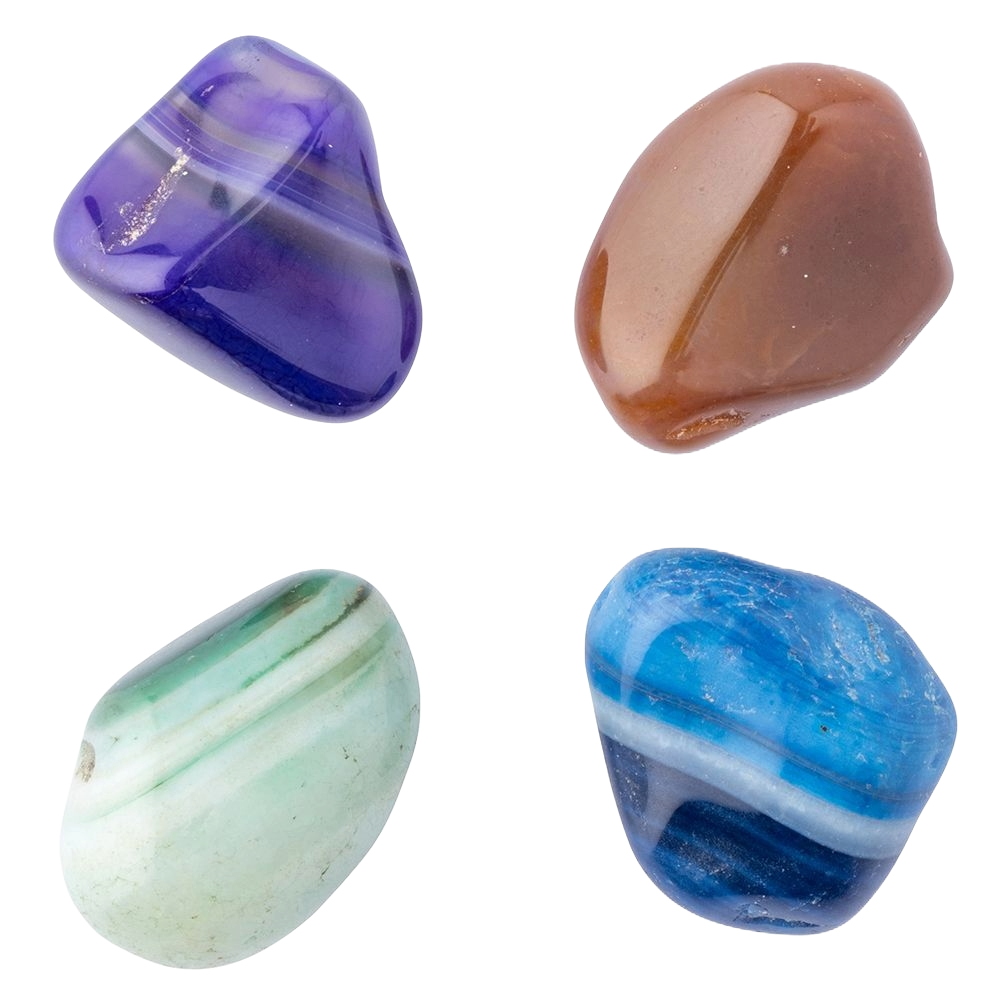
Banded agate, a captivating variety of chalcedony, is instantly recognisable by its distinct, concentric layers of colour. This gemstone, with its rich history and varied appearances, has been treasured for both its beauty and its perceived metaphysical properties for millennia.
Origins and Nomenclature:
The name “agate” originates from the Achates River (now the Dirillo) in Sicily, where agates were first discovered. “Banded” agate specifically refers to varieties displaying visible, layered patterns. Alternate names are often specific to the pattern or colour, such as “Sardonyx” (with alternating sard and onyx layers), “Eye Agate” (with circular banding resembling an eye), or “Fortification Agate” (with angular, zigzag patterns).
Composition and Physical Characteristics:
Banded agate is a form of cryptocrystalline quartz, meaning its crystals are too small to be seen with the naked eye. It primarily consists of silica (silicon dioxide) and is formed within volcanic or metamorphic rocks. The distinct banding is created by the deposition of silica-rich solutions in layers, often with varying mineral impurities that create the colour variations.
- Hardness: 6.5-7 on the Mohs scale.
- Lustre: Waxy to vitreous.
- Colour: A wide spectrum, including white, grey, brown, red, orange, pink, blue, green, and black.
- Transparency: Translucent to opaque.
Varieties and Locations:
The wide range of colours and banding patterns leads to numerous varieties, including:
- Sardonyx: Alternating layers of sard (brownish-red) and onyx (black or white).
- Carnelian Agate: Reddish-orange banding.
- Blue Lace Agate: Delicate blue and white banding.
- Moss Agate: Not truly banded, but features inclusions resembling moss or foliage.
- Crazy Lace Agate: Intricate, swirling patterns and vibrant colours.
- Botswana Agate: Known for its fine, parallel banding and grey, pink, and brown hues.
Significant deposits are found worldwide, including:
- Brazil: A major source of various types.
- India: Known for carnelian agate.
- Madagascar: Yielding colourful and patterned varieties.
- Mexico: Famous for crazy lace agate.
- Botswana: The origin of Botswana agate.
- Uruguay: Known for banded and geode agates.
- Germany: Historic agate cutting and polishing centre.
Archaeological and Significant Finds, Historical and Current Usage:
Agate artefacts have been found in archaeological sites dating back to the Neolithic period. Ancient civilisations, including the Egyptians, Greeks, and Romans, used agate for jewellery, seals, and decorative objects. Roman physicians used agate mortars and pestles for grinding medicines.
Today, banded agate is widely used in:
- Jewellery: Cabochons, beads, pendants, and carvings.
- Decorative Objects: Spheres, eggs, bookends, and paperweights.
- Lapidary Arts: Used for creating intricate carvings and cameos.
- Metaphysical Practices: Used for its grounding and balancing properties.
Interesting Facts, Folklore, Legends and Tales:
- Agate was believed to protect against storms and lightning in ancient times.
- It was also thought to bring strength, courage, and longevity.
- In some cultures, agate was used to ward off evil spirits and promote fertility.
- Medieval alchemists believed agate had the power to reveal hidden truths.
Mystical Healing Properties:
Banded agate is considered a grounding and stabilising stone. It is believed to:
- Promote inner stability, composure, and maturity.
- Strengthen security and self-confidence.
- Encourage acceptance of reality.
- Overcome negativity and bitterness of the heart.
- Heal inner anger or tension and create a sense of security and safety.
- Improve concentration, perception, and analytical abilities.
Links with Astrology and the Zodiac:
Banded agate is not traditionally associated with a specific zodiac sign, but its grounding properties resonate with Taurus and Gemini. Its diverse colours allow it to be linked with multiple planets.
The Chakra System:
Banded agate primarily resonates with the root chakra, providing grounding and stability. It can also be used to balance other chakras depending on its colour. Blue lace agate, for example, is associated with the throat chakra.
Link with a Birthstone and Wedding Anniversary:
Banded agate is not a traditional birthstone. However, it is sometimes associated with the 12th and 14th wedding anniversaries.
In summary, banded agate, with its beautiful patterns and grounding energy, continues to be a popular gemstone for both aesthetic and metaphysical purposes. Its rich history and diverse varieties ensure its enduring appeal.

Banded Agate
Stabilising and grounding, Banded Agate harmonises yin and yang energies. Supports emotional healing, concentration, and protection with layered strength.
